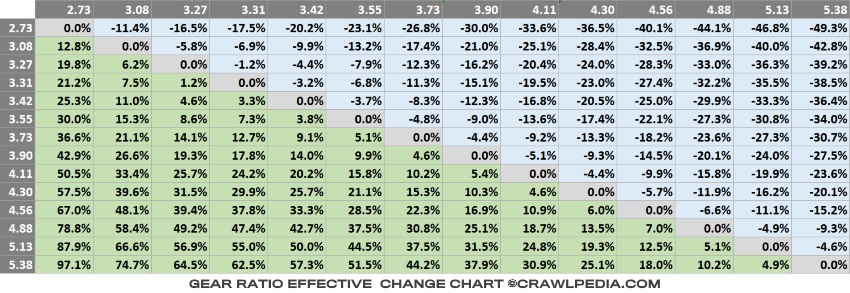Ring and Pinion Gear Ratio Calculator
Enter your original tire size and gear ratio into the form below along with your new tire size to find your recommended ring and pinion gear ratio.
Enter your original tire size and gear ratio into the form below along with your new tire size to find your recommended ring and pinion gear ratio.

Your axle gear ratio determines how many times your driveshaft needs to rotate in order to complete one full tire rotation (a 3.73 gear ratio requires 3.73 driveshaft rotations to turn your tires 360 degrees). Gear ratios have an effect on power, fuel efficiency, engine RPMs, and speedometer readings, so when you change tires sizes, up or down, keep in mind that these things will be impacted. While a small change in tire size may have almost no effect on your vehicle, installing 37" tires on a truck that originally came with 31" tires will result in a feeling of less power, lower operating RPMs, and a speedometer that is off by a few percent. Changing to a numerically higher gear ratio, as calculated below, will correct these problems.
|
For a complete list of gears available for your vehicle, visit the Filthy Motorsports Drivetrain Shop. |
Another helpful tool for deciding on a new gear ratio is this gear ratio effective difference chart. Start by finding your current gear ratio along the top row and then work your way down the column to find the effective difference of other gear ratios.
A 5% difference signifies a very small change and it is generally not worth the cost and effort to change gear ratios for such a minor difference. A 10% to 15% change will be noticeable and a 20% to 30% change will be significant. A negative percentage indicates a reduction in engine RPM as a result of the gear ratio change and a positive percentage will cause an increase in engine RPM.

To use this chart properly, drive the vehicle for a few weeks under all normal conditions and keep a journal of the current and desired RPM at all speeds. Then, calculate the differences across the range and determine what percentage change is needed. Keep in mind that the percentage will likely be different between low and high speeds so you will need to decide where that change is needed most or if a balance between the two is better.
This gear ratio calculator is ©Copyright Crawlpedia.com - Please provide a link back to this page when copying.
Data is accurate to the best of our knowledge and is offered as-is with no guarantee.
Differential Locker Comparison - A detailed comparison of popular differentials and lockers.
Ring and Pinion Setup Specs - Ring and pinion gear setup specifications for popular axles.
Ring and Pinion Gear Tooth Patterns - Gear tooth pattern setup and adjustement instructions.
Gear Ratio Calculator - Calculate the gear ratio of gears based on their tooth count.
Ring and Pinion Ratio Variations - An explanation of why some ring and pinion gear ratios vary.
Thick Gears and Carrier Breaks - Thick ring and pinion gears and differential carrier breaks explained.